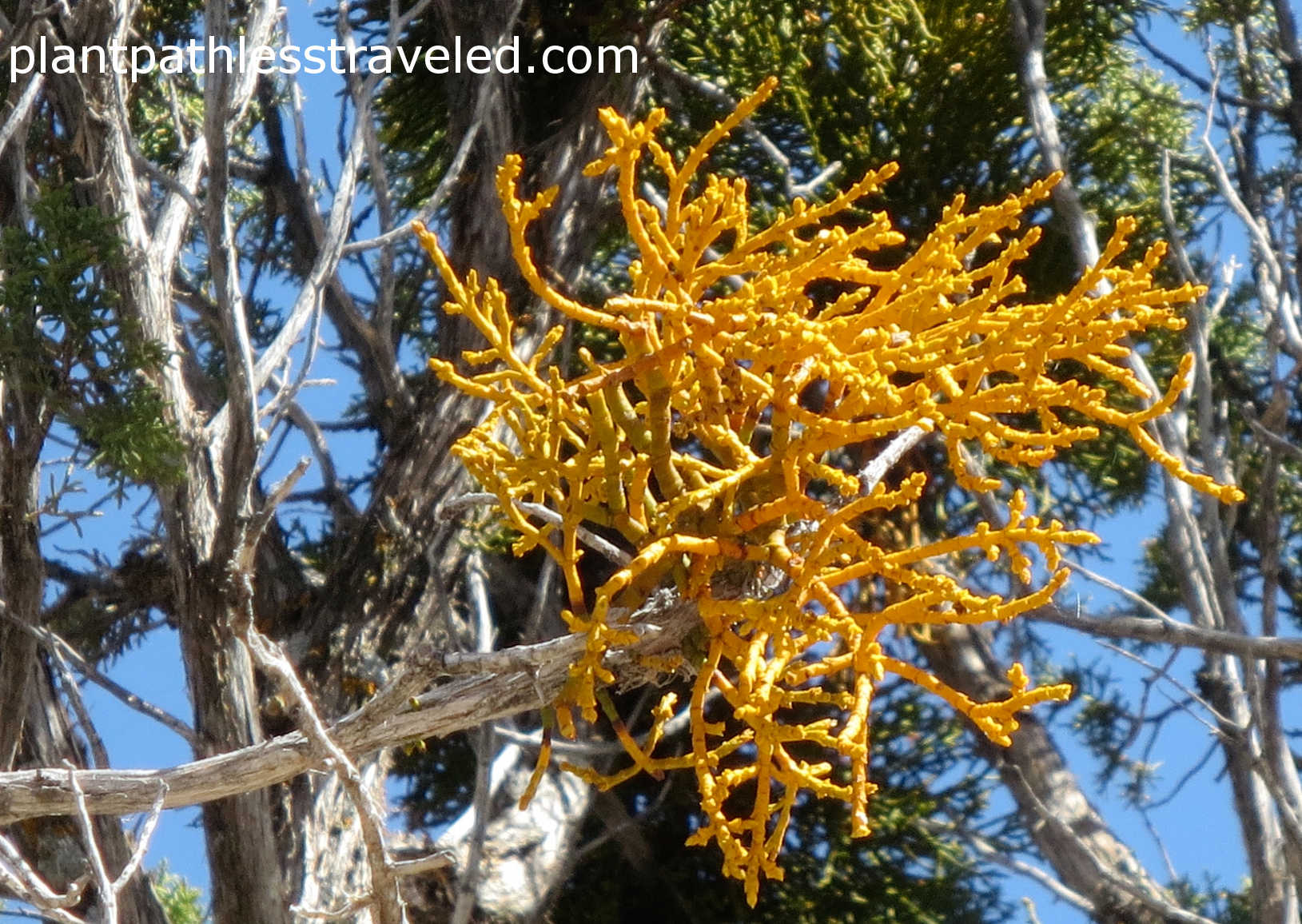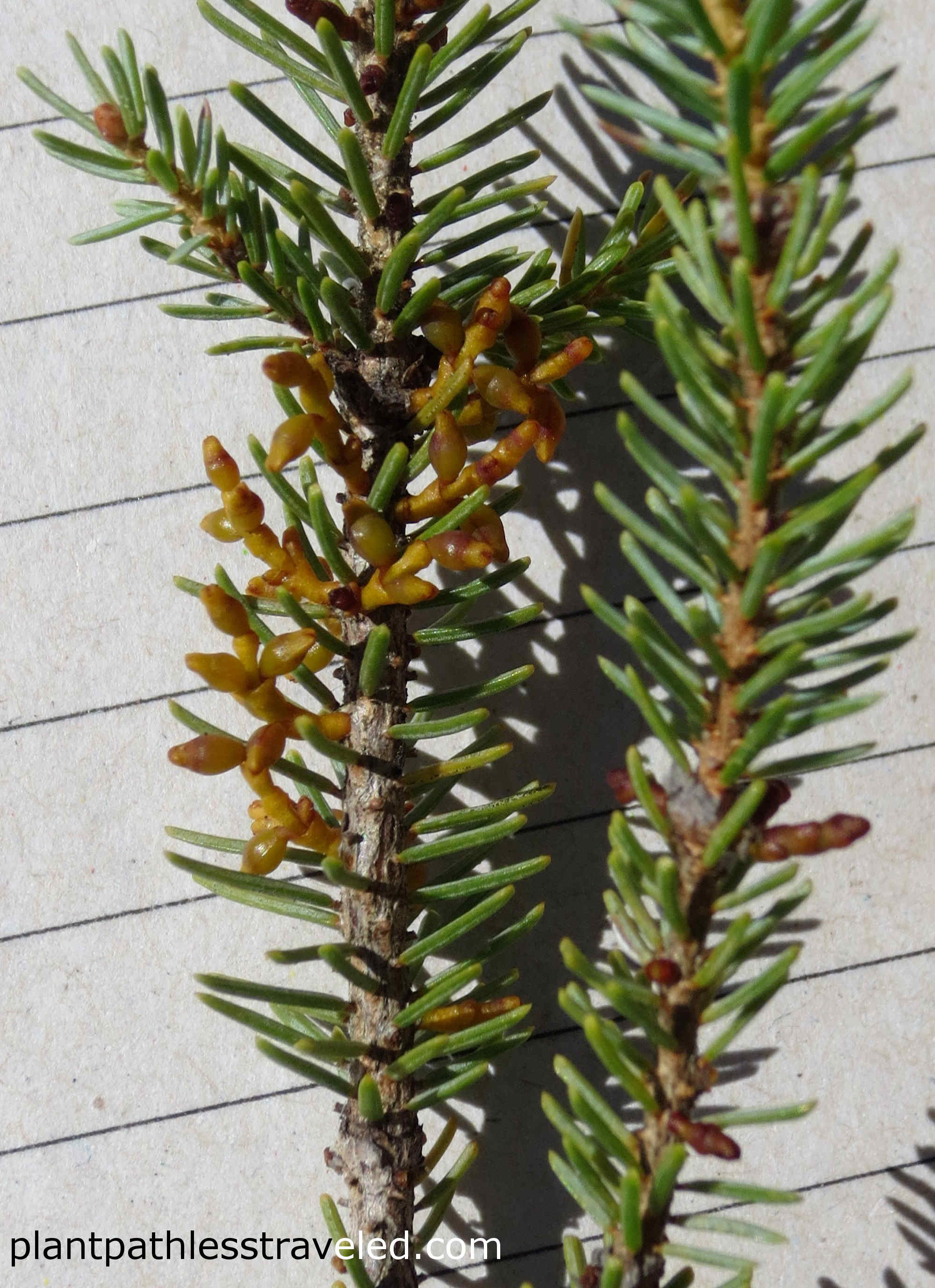Dwarf Mistletoe
Dwarf mistletoe is a plant pathogen that is most commonly found throughout North and Central America. This modified plant obtains the majority of its nutrients and all of its water from its host of confer or cypress trees. Best known for the ability of female plants to shoot seeds up to 50 feet away it is also a formidable challenge to manage in forests.
Introduction
Dwarf mistletoes belong to the genus Arceuthobium and are obligate parasitic plants on conifers and cypress trees and shrubs in North America. In the USA one can find dwarf mistletoe in the western states (Rocky mountain area) and northern states. Although the majority of dwarf mistletoes are found natively in North America they can also be found in Central America, Asia, Europe, and northern Africa. They can be identified by their camouflaged shoots of thin green, yellow, or brown stems. Depending upon the species the stems can be as short as 0.5 inch or as long as 28 inches. Another symptom produced by some species is the formation of witches’ brooms, or a proliferation of shoots (Hawksworth et al. 1998).


Dwarf mistletoes are characterized as plant pathogens because they derive most of their nutrition directly from the host plant. They are able to do this by using a specialized vascular system similar to plant roots. This system consists of tubes called haustoria which anchor the dwarf mistletoe into the host plant and allow it to take nutrients and water from the host. Dwarf mistletoe are also able to increase the translocation rate from the host plant to ensure a constant flow of water and nutrients (Wanner and Tinnin 1986). Dwarf mistletoe does have chlorophyll, but at only a level of 10-25% of what the host plant contains (Hull and Leonard 1964b). Reports suggest different dwarf mistletoe species are able to photosynthesize from 10-50% of their needed carbohydrates (Rey et al. 1991).
Life Cycle
Dwarf mistletoe is a dioecious plant having separate male and female plants. A life cycle can take from two to eight years to complete. Once a mature seed lands on a susceptible host it will germinate and attach to the host branch. After several years of growth inside the host the mistletoe plant will start growing shoots which can live for five or more years. Female plants will produce flowers either in early summer or late summer to fall. The seeds are dispersed by hydrostatic explosive discharge allowing a maximal spread of 52 feet, although distances of 30 feet are more likely (Robinson and Geils 2006). Squirrels and birds are also able to spread the seeds but it is not the major dispersal method (Nicholls et al. 1991). The seeds are coated with a sticky coating (viscin) so they do not bounce off of the needles they hit-but rather adhere to them. Despite these adaptations less than 10% of seeds land on a suitable infection site, but large numbers of seeds are produced per plant to ensure continued survival (Hawksworth 1965).

Impact
Dwarf mistletoes are considerable plant pathogens because they reduce: the growth rate, quality of wood (broken branches/dying tops), resistance to other diseases and insects (Kenaley et al. 2006), drought stress tolerance; and can increase the rate of wildfire spread due to the increase in dead branches in infected trees. However dwarf mistletoe is beneficial to numerous forest animals including: birds which use seeds as food and witches’ brooms as nesting sites; mammals which eat seeds, young shoots, and also use witches’ brooms as nesting sites and for cover; and for a variety of insects, mites, and spiders which eat the shoots, fruits, seeds, and other organisms present (Hawksworth et al. 1998).

Control
Numerous control measures have been developed for this plant pathogen with the simplest method being the removal of the infected branch or tree. This is not a perfect method however as it is difficult to determine the extent of infection in the tree and the entire dwarf mistletoe plant may not be removed. For larger areas chemical treatment with ethephon formulations (causes release of ethylene) will cause the plants to fall off of the host. This does not kill the dwarf mistletoe plant but does prevent it from spreading via seed. Applications must be repeated every one to three years for continued control. The final control measure is through controlled fires which will kill trees weakened by dwarf mistletoe and the dwarf mistletoe. The most extreme measure, which may be required for heavily infested forests, is to clear cut large areas to remove the dwarf mistletoe plants and seeds.
On your holiday travels this year make sure to take a look out the windows-you may spot an interesting plant pathogen decorating the trees.
All photos were taken by Sara Bratsch. For non commercial use only.
Please contact regarding all other uses.
Cite this article:
Bratsch, Sara. “Dwarf Mistletoe”. 23 December 2015. http://plantpathlesstraveled.com/dwarfmistletoe/
Article Citations
Hawksworth, F. G. (1965). Life Tables for Two Species of Dwarfmistletoe I. Seed Dispersal, Interception, and Movement. Forest Science, 11(2), 142-151.
Hawksworth, F. G., Brian, F. G. H. D. W., & Wiens, D. (1998). Dwarf mistletoes: biology, pathology, and systematics. DIANE Publishing.
Hoffman, J. (2004). Management Guide for Dwarf Mistletoe. Forest Health Protection and State Forestry Organizations, 14.
Hull, R. J., & Leonard, O. A. (1964). Physiological aspects of parasitism in mistletoes (Arceuthobium and Phoradendron). II. The photosynthetic capacity of mistletoe. Plant Physiology, 39(6), 1008.
Kenaley, S. C., Mathiasen, R. L., & Daugherty, C. M. (2006). Selection of dwarf mistletoe-infected ponderosa pines by Ips species (Coleoptera: Scolytidae) in northern Arizona. Western North American Naturalist, 66(3), 279-284.
Nicholls, T. H., Egeland, L., & Hawksworth, F. G. (1989). Birds of the Fraser Experimental Forest, Colorado, and their role in dispersing lodgepole pine dwarf mistletoe. Colorado Field Ornithology Journal, 23, 3-12.
Rey, L., Sadik, A., Fer, A., & Renaudin, S. (1991). Trophic relations of the dwarf mistletoe Arceuthobium oxycedri with its host Juniperus oxycedrus. Journal of plant physiology, 138(4), 411-416.
Robinson, D. C., & Geils, B. W. (2006). Modelling dwarf mistletoe at three scales: life history, ballistics and contagion. Ecological modelling, 199(1), 23-38.
Wanner, J., & Tinnin, R. O. (1986). Respiration in lodgepole pine parasitized by American dwarf mistletoe. Canadian Journal of Forest Research, 16(6), 1375-1378.